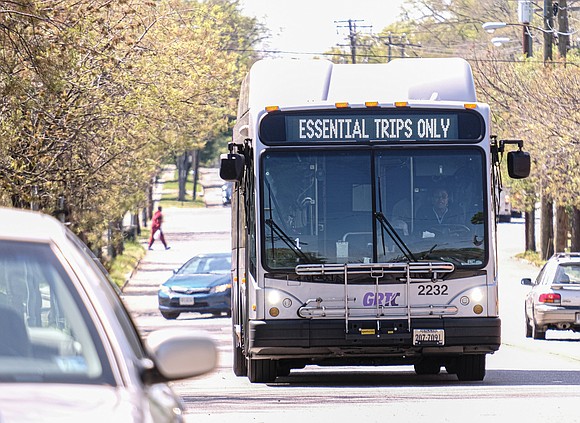GRTC gets $32 million infusion from federal CARES Act, keeping rides free
4/30/2020, 6 p.m.
Free fares on GRTC buses will continue through June 30 and could be extended at least through Dec. 30, according to information provided April 21 to the transit system’s board.
The city’s public transit system suddenly is flush with cash — with at least $32 million in stimulus funding from the federal CARES Act — and has less concern at the moment about maintaining service without the $500,000 a month in fare income, the board was told.
Julie Timm, chief executive officer of GRTC, explained that the federal infusion of cash, along with other new funding, should ensure the essential transportation service can keep running without fares as long as the drivers and maintenance staff continue to show up.
Richmond got a taste of what would happen if the unionized drivers stop working when at least 46 drivers called in sick Sunday and stayed home Monday, forcing GRTC to cut back to hourly service on regular routes most of Monday.
Pulse service also was slowed, although most of the drivers assigned to the rapid transit system came to work, GRTC spokeswoman Carrie Rose Pace stated. CARE Van service was not affected, she added.
Despite claims from GRTC that the protest amounted to an illegal work stoppage, Maurice Carter, president of Amalgamated Transit Union Local 1220, said the sickout was not sanctioned. He said drivers arranged the protest on their own to call attention to GRTC’s failure to heed a union request for greater driver health protection by requiring all passengers to wear masks or mouth and nose coverings. The drivers also rejected GRTC's offer of a 50 cents an hour increase for hazardous duty pay during the coronavirus pandemic.
Drivers returned to work Tuesday to the relief of the company, but Mr. Carter said the union would continue to negotiate on the mask issue and for hazardous pay.
In a last-ditch effort Sunday evening to prevent the sickout, Ms. Timm issued a memo to company employees announcing that she was awarding bonuses of $300 to $500 for drivers and other workers that would appear in May checks. She did not address the mask issue.
Ms. Timm stated the bonuses are the best the company could do for now in rejecting an April 20 request from Mr. Carter calling for drivers to receive time-and-a-half for all hours worked. He later requested $6 an hour. The case for hazard pay improved Wednesday when Mr. Carter reported the first driver to test positive for for COVID-19. The driver is in quarantine, he said, but it shows the risk drivers face.
Despite the influx of funds, Ms. Timm stated that GRTC could struggle if the economy plunges into a recession. She said the company needs to be careful with the extra money to avoid layoffs and service cuts if there is no recovery.
The drivers, who make between $15.50 and $23.84 an hour, are generally unimpressed with the bonus.
“The bonus is nice but it won’t amount to much after taxes,” one driver said. “We deserve better. Kroger is paying their workers an extra $2 an hour, and we deserve at least a $1 an hour increase, not 50 cents.”
Mr. Carter said he believes GRTC has the money, noting that the national union reports the company is to receive $35.8 million in federal relief, $3.8 million more than Ms. Timm indicated.
The new federal dollars are on top of other financial aid the company has received or projects to receive through other sources, which is helping GRTC stand out among the nation’s transit systems in its ability to persevere in the face of the pandemic.
Ms. Timm said she plans to present to the board an option to keep the free rides in place at least through December in the proposed 2020-21 budget she will present in May and possibly through the entire next fiscal year that will end June 30, 2021. She said the idea is to keep in place rear-door boarding and other changes that reduce interaction between drivers and passengers just in case there is a resurgence of COVID-19 in the fall, as some medical experts have warned.
GRTC’s suddenly swollen bank account is expected to quell concerns among members of Richmond City Council about Mayor Levar M. Stoney’s plan to cut the city’s subsidy for GRTC by $7.9 million, or 50 percent, in the new 2020-21 fiscal year that begins July 1.
Henrico County also is planning to cut about $4.2 million, or 50 percent, from its current $8.4 million GRTC subsidy in the upcoming 2020-21 fiscal year.
Receipt of the federal money is huge for GRTC, which currently operates on a $55.6 million annual budget. Those federal dollars also are far in excess of the costs, including overtime, which GRTC has had to absorb from COVID-19. Those costs are projected to hit $194,000 by June 30, GRTC staff reported.
Ms. Timm told the board that GRTC also anticipates receiving an additional $15 million between July 1, 2020, and June 30, 2021, from the new Central Virginia
Transportation Authority that the General Assembly created to support public transit, fund new road development in the Richmond area and provide extra funding for street paving and other road needs in Richmond and eight other localities.
The CVTA’s funds are to be generated by a hike in the gas tax and from a 7/10ths of 1 percent increase in the sales tax, although the sales tax increase has been delayed until Oct. 1 because of recession concerns.
Before the virus hit, GRTC had been projected to receive about $26 million a year through the CVTA, with Henrico and Richmond relying on that projection to cut their subsidies.
GRTC already has received nearly $1.17 million extra from the state that enabled it to eliminate fares in mid-March after a state of emergency was imposed and to cover initial costs incurred because of the coronavirus. Without the federal and state support, Ms. Timm said GRTC, which has no savings or lines of credit, would have been hard-pressed to keep buses rolling. She said GRTC is being cautious about the federal funds, based on a worst case scenario in which the company receives little or no money from the CVTA in the first 12 months.
Ms. Timm told the board that Richmond’s ridership is down only by about 30 percent because of the stay-at-home order, a contrast to other places that are reporting 80 percent to 95 percent drops in transit ridership. She said that indicates the importance of bus service to low-income area residents. She cited data that only 25 percent of GRTC riders have annual incomes above $50,000, while 54 percent have annual incomes of $25,000 or less.
While doctors, nurses and ambulance first responders are getting the most recognition, the Rev. Benjamin P. Campbell of Richmond, chairman of the GRTC board, said bus drivers are among those who are showing what it takes to keep a society functioning in emergency conditions.







